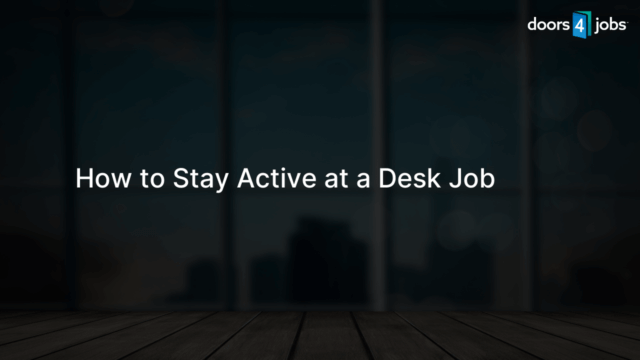Stretch at your desk job every 30-60 minutes for 5-10 minutes to alleviate muscle tension, maintain flexibility, and promote blood circulation, ultimately enhancing productivity and overall well-being.
Benefits of Stretching at Your Desk Job
Stretching at a desk job is crucial for maintaining good posture, reducing muscle tension, alleviating joint stress, promoting blood circulation, and increasing productivity. Regular stretching also helps prevent common workplace ailments, such as back pain and carpal tunnel syndrome.
Frequency of Stretching at Your Desk
To maximize the benefits of stretching, aim to stretch every 30-60 minutes throughout your workday. Taking 5-10 minute breaks to stretch will help maintain flexibility, relieve muscle tightness, and improve mental focus.
Strategies for Remembering to Stretch
- Set reminders on your phone or computer to take stretching breaks.
- Use a sit-stand desk, which will encourage movement and posture changes throughout the day.
- Combine stretching with other short breaks, like getting a glass of water or going to the restroom.
Desk Job Stretching Exercises
Here are a few simple and effective stretching exercises you can perform at your desk to alleviate muscle tension and improve focus:
Neck Stretches
- Sit up straight and slowly tilt your head to one side, bringing your ear towards your shoulder. Hold for 15-30 seconds, then repeat on the other side.
- Lower your chin towards your chest, hold for 15-30 seconds, then slowly lift your head back up.
Shoulder and Upper Back Stretches
- Roll your shoulders in a circular motion, both forwards and backwards, for approximately 10-15 seconds in each direction.
- Interlace your fingers and reach your arms straight up overhead. Hold for 10-15 seconds, then release.
Wrist and Forearm Stretches
- Extend one arm straight out in front of you, with your palm facing downwards. Gently pull your fingers back toward your body using your other hand. Hold for 15-30 seconds and repeat with the other arm.
- Press the palms of your hands together like a prayer position. Slowly push your hands downward while keeping the palms together until you feel a stretch in your wrists. Hold for 10-15 seconds.
Lower Back and Hip Stretches
- While seated, cross one ankle over the opposite knee, then gently press down on the elevated knee. Lean forward slightly to intensify the stretch. Hold for 15-30 seconds, then switch legs.
- Stand up and place your hands on your hips. Slowly bend backwards until you feel a gentle stretch in your lower back. Hold for 5-10 seconds, then return to the starting position.
Creating a Stretching Routine
Developing a personalized stretching routine ensures that you target all the necessary muscle groups and encourages a consistent habit. Start by identifying the areas in your body that feel the most strain while at your desk job, such as your neck, shoulders, or lower back. Incorporating relevant stretches for these areas can make a significant difference in overall comfort and muscle health.
Trying Different Stretching Techniques
Experiment with various stretching techniques to find the ones most suited to your needs:
- Static stretching: Holding a stretch for an extended period, typically 15-30 seconds.
- Dynamic stretching: Performing controlled movements through a range of motion to improve flexibility and warm up your muscles.
- PNF stretching: Proprioceptive Neuromuscular Facilitation involves contracting and relaxing the targeted muscle group as part of the stretch.
Building Healthy Habits
Stretching is just one aspect of maintaining a healthy and pain-free work environment. Cultivating other positive habits while working can further enhance your overall well-being:
Maintain Good Posture
Good posture is essential in reducing tension, minimizing pressure on your joints, and optimizing comfort. Proper ergonomics at your workspace can help ensure correct posture throughout the day:
- Adjust chair height so that your feet remain flat on the ground, with your knees and hips aligned at a 90-degree angle.
- Keep your monitor at eye level to prevent strain on your neck and shoulders.
- Place the keyboard and mouse close to your body, so your arms can rest comfortably while typing.
Take Regular Breaks
Apart from stretching, taking short walks or periodic breaks during your workday can reduce mental fatigue, boost productivity, and promote healthy circulation. Aim for a 5-minute break every hour to relax and recharge your mind and body.
Stay Hydrated
Drinking water is crucial for your well-being and concentration. Keep a water bottle at your desk as a visual reminder to stay hydrated throughout the day.
Manage Stress
Implementing stress management techniques can aid in maintaining a healthy work-life balance. Consider practicing deep breathing exercises, mindfulness, or listening to calming music to reduce stress levels during your day.
Consult a Professional
If you experience chronic pain or discomfort while working at a desk, consulting a professional, such as a physical therapist or ergonomics expert, can be valuable in finding customized solutions to prevent further issues and enhance your overall workplace experience.
FAQ Section
Here are some frequently asked questions that may arise after reading this blog post, along with concise, direct answers to provide additional clarity and understanding of the topic.
Why is it important to stretch at a desk job?
Stretching at a desk job helps maintain good posture, reduces muscle tension, alleviates joint stress, promotes blood circulation, and increases productivity. It also prevents common workplace ailments, such as back pain and carpal tunnel syndrome.
How long should I stretch during my workday?
Take 5-10 minute stretching breaks every 30-60 minutes throughout your workday. This frequency helps maintain flexibility, relieve muscle tightness, and improve mental focus.
What are some simple stretches I can do at my desk?
Simple desk stretches include neck tilts, shoulder rolls, overhead reaches, wrist and forearm stretches, and seated hip stretches. Performing these stretches can alleviate muscle tension and promote relaxation.
How can I remember to stretch during my workday?
To remember to stretch, set reminders on your phone or computer, use a sit-stand desk, or combine stretching with other short breaks, like getting a glass of water or going to the restroom.
Should I consult a professional if I experience chronic pain at my desk job?
Yes, if you experience chronic pain or discomfort while working at a desk, consult a professional, such as a physical therapist or ergonomics expert, for customized solutions to prevent further issues and improve your overall workplace experience.











